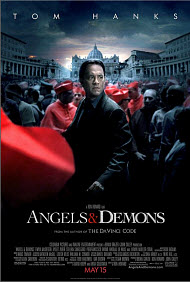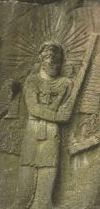The Original Illuminati

Many people have heard of a group sometimes referred to as the Illuminati. Notice the following about the Angels & Demons movie:
Producer’s Synopsis: “Angels and Demons was the reclusive author’s third novel after he gave up his job as an English teacher. It tells the story of Langdon’s brush with a shadowy secret society, the Illuminati, and his frantic quest for the world’s most powerful energy source, in the company of a beautiful Italian physicist whose father, a brilliant physicist, has been murdered. http://www.christiananswers.net/spotlight/movies/2009/angelsanddemons2009.html
The Illuminati that Angels & Demons refer to are generally traced to Bavaria in 1776. But the Bavarians were not the original illuminati.
Most do not realize that the second century heretic Justin and others got the illumination idea from the followers of the pagan sun-god Mithra.

Mithra Had a Halo
Notice what Wikipedia’s article on Halos reports:
Round “solar discs” above the head are seen in depictions of many deities of Ancient Egypt, including Ra and Hathor, and symbols resembling later haloes, such as the sun cross, are found in many ancient religions, especially in connection with sun worship. Homer describes a more-than-natural light around the heads of heroes in battle, and in Aristophanes’ Birds the founder of Cloud-Cuckoo-Land is extravagantly said to outshine stars and sun. Depictions of Perseus in the act of slaying Medusa, with lines radiating from his head, appear on a white-ground toiletry box in the Louvre and on a slightly later red-figured vase in the style of Polygnotos, ca. 450-30 BC, in the Metropolitan Museum of Art. On painted wares from south Italy radiant lines or simple haloes appear on a range of mythic figures: Lyssa, a personification of madness; a sphinx, a sea demon, Thetis, the sea-nymph who was mother to Achilles, The Colossus of Rhodes, was a statue of the sun-god Helios and had his usual radiate crown (copied by the Statue of Liberty). Hellenistic rulers are often shown wearing radiate crowns that seem clearly to imitate this effect. A more prosaic influence that has been cited by some historians is the Greek practice of placing circular metal discs above the head of statues to protect them from birds and their droppings, thus anticipating the “perspectival” halo by over a millennium. In Asian art The halo and the aureole have been widely used in Indian art, particularly in Buddhist iconography where it has appeared since at least the 1st century AD; the Kushan Bimaran casket in the British Museum is variously dated between 30BC and 60AD.
And while other pagan systems had an illuminating “halo”, the one that came into the main Western religions apparently came from Mithraism as a sign of being illuminated.
Are you aware that one objective of mystery religions like Mithraism was to become illuminated? Notice the following:
FOR more than three centuries Mithraism was practised in the remotest provinces of the Roman empire and under the most diverse conditions…the promise of complete illumination, long withheld, fed the ardor of faith with the fascinating allurements of mystery…The gods were everywhere, and they mingled in every act of life; the fire that cooked the food and warmed the bodies of the faithful, the water that allayed their thirst and cleansed their persons, the very air that they breathed, and the light that illuminated their paths, were the objects of their adoration. Perhaps no other religion ever offered to its sectaries in a higher degree than Mithraism opportunities for prayer and motives for veneration (Cumont, Franz. Translated from the second revised French edition by Thomas J. McCormack. The Mysteries of Mithra. Chicago, Open Court [1903] pp. 104,120,149).
Justin, and those influenced by him, had practices that were similar to those employed by the followers of the sun-god Mithra:
For, in the name of God, the Father and Lord of the universe, and of our Saviour Jesus Christ, and of the Holy Spirit, they then receive the washing with water…And this washing is called illumination, because they who learn these things are illuminated in their understandings (First Apology 61).
And this food is called among us Εύχαριστία [the Eucharist], of which no one is allowed to partake but the man who believes that the things which we teach are true, and who has been washed with the washing that is for the remission of sins, and unto regeneration, and who is so living as Christ has enjoined. For not as common bread and common drink do we receive these; but in like manner as Jesus Christ our Saviour, having been made flesh by the Word of God, had both flesh and blood for our salvation, so likewise have we been taught that the food which is blessed by the prayer of His word, and from which our blood and flesh by transmutation are nourished…Which the wicked devils have imitated in the mysteries of Mithras, commanding the same thing to be done. For, that bread and a cup of water are placed with certain incantations in the mystic rites of one who is being initiated, you either know or can learn (First Apology 66).
Then we all rise together and pray, and, as we before said, when our prayer is ended, bread and wine and water are brought, and the president in like manner offers prayers and thanksgivings, according to his ability, and the people assent, saying Amen; and there is a distribution to each, and a participation of that over which thanks have been given, and to those who are absent a portion is sent by the deacons. And they who are well to do, and willing, give what each thinks fit; and what is collected is deposited with the president, who succours the orphans and widows and those who, through sickness or any other cause, are in want, and those who are in bonds and the strangers sojourning among us, and in a word takes care of all who are in need. But Sunday is the day on which we all hold our common assembly (First Apology 67).
Hence those that were like Justin were a type of pagan illuminati.
Lest anyone think that Justin did not, notice what the historian and scholar K. Latourette observed:
One of the earliest descriptions of the Eucharist, that by Justin Martyr, not far from the middle of the second century, recognizes the similarity to what was seen in one the mystery cults, Mithraism…it has been repeatedly asserted that in baptism and the Eucharist Christians borrowed from the mysteries and that Christianity was simply another one of these cults…The similarity is striking (Latourette KS. A History of Christianity, Volume 1: to A.D. 1500. HarperCollins, San Francisco, 1975, p. 198).
Of course, true Christianity could not “borrow” from the sun-cults, but Justin and those that follow his examples apparently have.
It should be understood that while Justin calls the newly baptized “illuminated” the Bible does not.
I suspect that some who had some connection with Mithraism professed Christ and that those ceremonies got picked up by apostates who Justin apparently distantly came into contact with. And even though Justin is attempting to state that Mithraism copied “Christian” ceremonies, the fact is that the Mithra ceremonies, including Sunday worship, were in existence prior to Jesus coming. Jesus, of course, kept Saturday for the Sabbath.
Hence it would appear that those who practiced Sunday, called baptized persons “illuminated” (a term indicating “light”, such as sunlight), and who practicing the mystic eucharistic ceremonies were following non-Christian influences as it obviously did not happen the other way around with these practices.
Sadly, however, it seems that many non-biblical practices slowly became part of the Greco-Roman churches. And many still revere heretic Justin as a saint today.
And while adopting non-biblical practices apparently was probably not intentional on the part of people like Justin, the relatively early acceptance of such non-biblical practices seems to have led to additional ones being added later. Would the true Church have adopted pagan practices?
Some articles of possibly related interest may include:
Justin Martyr: Saint, Heretic, or Apostate? Justin is considered one of the first Christian theologians and scholars. But did he support a Gnostic version of Christianity? Do you know what he taught about souls going to heaven upon death? This article shows from his own writings, what Justin really taught.
Marcus, the Marcosians, & Mithraism: Developers of the Eucharist? Marcus was a second century heretic condemned for having a ceremony similar to one still practiced by many who profess Christ. Might he also be in the apostolic succession list of the Orthodox Church of Alexandria?
Sunday and Christianity Was Sunday observed by the apostolic and true post-apostolic Christians? Who clearly endorsed Sunday?
The Sabbath in the Early Church and Abroad Was the seventh-day (Saturday) Sabbath observed by the apostolic and post-apostolic Church?
The History of Early Christianity Are you aware that what most people believe is not what truly happened to the true Christian church? Do you know where the early church was based? Do you know what were the doctrines of the early church? Is your faith really based upon the truth or compromise?
 |
Tweet |
|